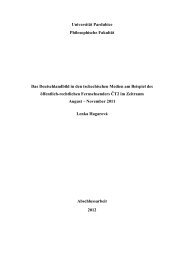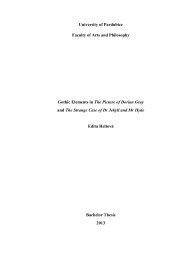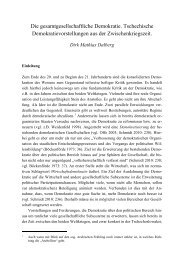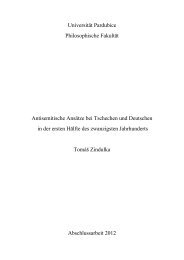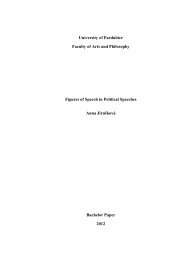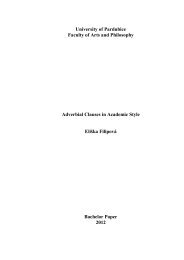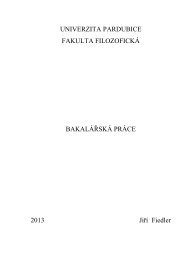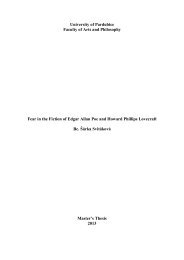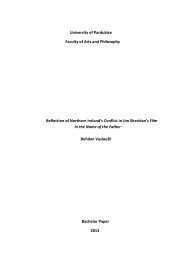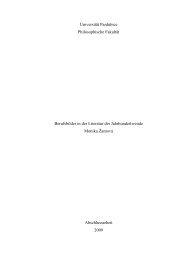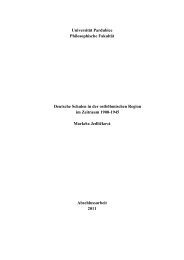University of Pardubice Jan Perner Transport Faculty Transport and ...
University of Pardubice Jan Perner Transport Faculty Transport and ...
University of Pardubice Jan Perner Transport Faculty Transport and ...
Create successful ePaper yourself
Turn your PDF publications into a flip-book with our unique Google optimized e-Paper software.
Motorized transportation by potential means: New transport patterns must emerge, according<br />
to which larger volumes <strong>of</strong> freight <strong>and</strong> greater numbers <strong>of</strong> travellers are carried jointly to their<br />
destination by the most efficient (combination <strong>of</strong>) modes. Individual transport is preferably used<br />
for the final miles <strong>of</strong> the journey <strong>and</strong> performed with clean vehicles.<br />
Some access depends on the use <strong>of</strong> quite different technologies from those in common use today.<br />
They might include fuel cells using renewable resources such as hydrogen produced with solar<br />
energy, intelligent transportation systems, automated highways, maglev rail services, <strong>and</strong> airship<br />
technologies. Together they provide cleaner, more conserving, <strong>and</strong> safer movement <strong>of</strong> people <strong>and</strong><br />
goods. The movement <strong>of</strong> goods utilizes modes <strong>of</strong> transport appropriate to the size <strong>and</strong> distance <strong>of</strong><br />
shipment <strong>and</strong> to the minimization <strong>of</strong> resulting emissions. Shippers <strong>and</strong> carriers include<br />
environmental as well as financial goals in selecting the timing <strong>and</strong> mode <strong>of</strong> shipping.<br />
Less need for movement <strong>of</strong> people <strong>and</strong> goods: Whatever the mode, journeys made by<br />
motorized transport are shorter on average than in early 2000’s , for the movement <strong>of</strong> both people<br />
<strong>and</strong> goods in part because urban areas are more compact <strong>and</strong> have a good mix <strong>of</strong> uses. More<br />
access is achieved through telecommunications, with less movement <strong>of</strong> people or goods.<br />
Little or no impact on the environment <strong>and</strong> on human health: The net result is dramatically<br />
lower local <strong>and</strong> global impacts <strong>of</strong> transportation on the environment. The impacts are so low they<br />
no longer provide reason for concern about people's health or any part <strong>of</strong> the natural environment,<br />
in the present or the future. In particular, emissions <strong>of</strong> carbon dioxide <strong>and</strong> other greenhouse gases<br />
from transportation are less than one fifth <strong>of</strong> the total <strong>of</strong> such emissions in the 1990s.<br />
Methods <strong>of</strong> attaining <strong>and</strong> sustaining the vision: As well as changes in urban areas that<br />
facilitate collective transportation, bicycling, <strong>and</strong> walking, there has been <strong>and</strong> continues to be<br />
rigorous application <strong>of</strong> the full costs <strong>of</strong> transportation, supported by appropriate incentives <strong>and</strong><br />
also by enforcement <strong>of</strong> st<strong>and</strong>ards for vehicles, fuels, <strong>and</strong> infrastructure<br />
Non-urban areas: While the opportunities for achieving sustainable transportation in rural areas<br />
may be different <strong>and</strong> perhaps more limited when compared to urban areas, Canadians living in<br />
rural areas can make a positive contribution towards transportation sustainability.<br />
- 54 -



